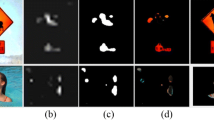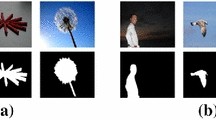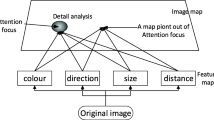Abstract
This paper presents a novel wavelet transform saliency model to detect salient objects. In this model, a saliency map is generated by combining orientation feature maps obtained from wavelet transform of different scale images derived from the same image. Then, the order map of a saliency map is obtained by using Fourier descriptor, which could be used as a guidance to process the most important objects. Experiments indicate that this saliency model is robust to noise and superior to other saliency models in the literature.
Similar content being viewed by others
References
von Grünau M, Iordanova M. Visual selection: Facilitation due to stimulus saliency. In: Proceedings of the II Workshop on Cybernetic Vision, Sao Carlos, Brazil, 1996. 15-20
Niebur E, Koch C. Computational architectures for attention. In: Parasuraman R, ed. The Attentive Brain. Cambridge: MIT Press, 1998. 163–186
Gilles S. Robust description and matching of Images. PhD thesis. Oxford of Britain: University of Oxford, 1998
Loupias E, Sebe N, Bres S, et al. Wavelet-based salient points for image retrieval. IEEE Conf Image Process, Vancouver, BC, Canada, 2000, 2: 518–521
Kingsbury N G. Complex wavelets for shift invariant analysis and filtering of signals. Appl Comput Harmon Anal, 2001, 10: 234–253
Fauqueur J, Kingsbury N, Anderson R. Multiscale keypoint detection using the Dual-Tree complex wavelet transform. In: IEEE Conf Image Processing, Atlanta, GA, USA, 2006. 1625–1628
Laurent C, Laurent N, Maurizot M, et al. In depth analysis and evaluation of saliency-based color image indexing methods using wavelet salient features. Multimed Tools Appl, 2006, 31: 73–94
Mikolajczyk K, Schmid C. An affine invariant interest point detector. In: Proceedings of the European Conference on Computer Vision, London: Springer-Verlag, 2002. 128–142
Schmid C, Mohr R, Bauckhage C. Evaluation of interest point detectors. Int J Comput Vision, 2000, 37: 151–172
Sebe N, Lew M S. Comparing salient point detectors. Pattern Recogn Lett, 2003, 24: 89–96
Carson C, Belongie S, Greespan H, et al. Blobworld: image segmentation using expectationmaximization and its application to image querying. IEEE Trans Pattern Anal Mach Intell, 2002, 24: 1026–1038
Wang J Z, Li J, Wiederhold G. Simplicity: semantics-sensitive integrated matching for picture libraries. IEEE Trans Pattern Anal Mach Intell, 2001, 23: 947–963
Shokoufandeh A, Marsic I, Dickinson S J. View-based object recognition using saliency maps. Image Vision Comput, 1999, 17: 445–460
Kadir T. Scale, Saliency, Scene Description. PhD thesis. Oxford of Britain: University of Oxford, 2001
Kadir T, Brady M. Saliency, scale and image description. Int J Comput Vision, 2001, 45: 83–105
Itti L, Koch C, Niebur E. A model of saliency-based visual attention for rapid scene analysis. IEEE Trans Pattern Anal Mach Intell, 1998, 20: 1254–1259
Itti L, Koch C. Feature combination strategies for saliency-based visual attention systems. J Electr Imag, 2001, 10: 161–169
Hou X D, Zhang L Q. Saliency detection: A spectral residual approach. In: IEEE Conf Computer Vision and Pattern Recognition, Minneapolis, MN, 2007. 1–8
Wilson H R. Psychophysical models of spatial vision and hyperacuity. Spatial Vision, 1991, 10: 64–81
Daly S J. The visible differences predictor: an algorithm for the assessment of image fidelity. In: Watson A B, ed. Digital Images and Human Vision. Cambridge: MIT Press, 1993. 179–206
Lubin J. A visual discrimination model for imaging system design and evaluation. In: Peli E, ed. Vision Models for Target Detection, World Scientific Publishing, 1995. 245–283
Pattanaik S N, Fairchild M D, Ferwerda J A, et al. Multiscale model of adaptation, spatial vision and color appearance. In: The Sixth Color Imaging Conference: Color Science, Systems and Applications, Scottsdale, 1998. 2–7
Hopf J M, Boehler C N, Luck S J, et al. Direct neurophysiological evidence for spatial suppression surrounding the focus of attention in vision. Proc Natl Acad Sci USA, 2006, 103: 1053–1058
Cutzu F, Tsotsos J K. The selective tuning model of attention: psychophysical evidence for a suppressive annulus around an attended item. Vision Res, 2003, 43: 205–219
Paffen C L, van der Smagt M J, te Pas S F, et al. Center-surround inhibition and facilitation as a function of size and contrast at multiple levels of visual motion processing. J Vision, 2005, 5: 571–578
Mallat S G. A theory for multiresolution signal decomposition: the wavelet representation. IEEE Trans Pattern Anal Mach Intell, 1989, 11: 674–693
Daubechies I. Ten Lectures on Wavelets. Philadelphia: Society for Industrial and Applied Mathematics, 1992
Levitt J B, Lund J S. Contrast dependence of contextual effects in primate visual cortex. Nature, 1997, 387: 73–76
Nothdurft H C. Saliency effects across dimensions in visual search. Vision Res, 1993, 33: 839–844
Nothdurft H C. Salience from feature contrast: additivity across dimensions. Vision Res, 2000, 40: 1183–1201
Petkovic T, Krapac J. Shape description with Fourier descriptors. Tehnical Report. 2002
Kunttu I, Lepistö L, Rauhamaa J, et al. Multiscale Fourier descriptors for defect image retrieval. Pattern Recogn Lett, 2006, 27: 123–132
Chun S L, Chia H L. New forms of shape invariants from elliptic fourier descriptors. Pattern Recogn, 1987, 20: 535–545
Kim H K, Kim J D. Region-based shape descriptor. invariant to rotation, scale and translation. Signal Process Imag, 2000, 16: 87–93
Mokhtarian F, Mackworth A K. Scale-based description and recognition of planar curves and two-dimensional shapes. IEEE Trans Pattern Anal Mach Intell, 1986, 8: 34–43
[Online]. Available: http://bcmi.sjtu.edu.cn/houxiaodi.
Author information
Authors and Affiliations
Corresponding author
Rights and permissions
About this article
Cite this article
Li, Z., Fang, T. & Huo, H. A saliency model based on wavelet transform and visual attention. Sci. China Inf. Sci. 53, 738–751 (2010). https://doi.org/10.1007/s11432-010-0055-3
Received:
Accepted:
Published:
Issue Date:
DOI: https://doi.org/10.1007/s11432-010-0055-3




